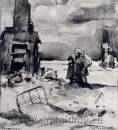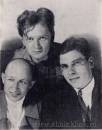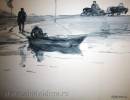Museum Collection
Illustrations for the Book вАЬThe Fate of a ManвАЭ
19 illustrations for M.A. Sholokhov’s story “The Fate of a Man” by well-known Kukryniksi artists – Mikhail Vasiliyevich Kupriyanov, Porfiriy Nikitovich Krylov, Nikolay Alexandrovich Sokolov are kept in the holding of the State M.A. Sholokhov Museum-Reserve. The People’s Artists of the USSR, Heroes of Socialist Labour, Lenin Prize laureates, they decided to illustrate Sholokhov’s story because “in this small-size work we saw a great theme exciting for everyone – a strength of Soviet man. The strength, which withstood even the war with its terrible consequences: loss of the family and home, deaths of friends, enormous torments in the fascist concentration camps”.
The artists sent a letter to the Museum of M.A. Sholokhov, where they told about their work: “Already in the time of our travelling by the front roads, about the towns and villages liberated from the German occupation we saw many tragic scenes. Our soldiers were the first people to see enormous human grief, they were met by the residents with tears of joy in their eyes, they raised their orphaned children in their hands.
These recollections came to life many years later after the war, when we read the story “The Fate of a Man” by Mikhail Sholokhov. He wrote so truthfully and brightly to bring a vivid recollection of the scenes of that historic war time before our eyes again.
We decided to make the illustrations according to our vision recollections not limiting the drawings by the theme of this story. We wanted to expand the illustrative material supplementing the book with a series of plots, which, though do not exist in the book, but yet are visualized before the reader’s eyes.
We tried to make a two-scale colour design: almost all the pictures about the German occupation, especially concentration camps, were made in hard gloomy colours. And vice versa, joyful episodes like the meeting of Andrey Sokolov and Vanyushka were designed in bright, sunny colours. Depending on the subject of the drawing we tried to make even landscapes either joyful, light or grey and dull.
As well as in every other work we had been seeking for a type, circumstances, scenes of nature for long, all the time turning to what we had seen and experienced”.
Valentina Leonova














